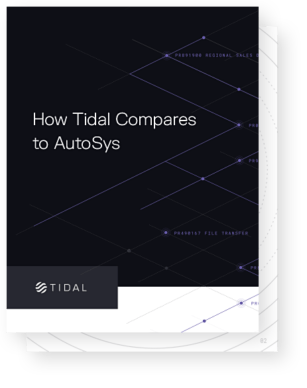Your AutoSys Alternative Is Here
There are some distinct differences that make Tidal a more robust, comprehensive solution for enterprise workload automation:
- 100% Focus on Workload Automation
- Always CustomerFIRST
- High-velocity Product Development
- Exceptional Technical Support
- Flexible, Transparent Pricing

What is Tidal workload automation?
Tidal software is a unified workload automation platform that provides teams with a centralized location for job scheduling and management of business processes.
Tidal workload automation offers 60+ integrations for automating applications, middleware, physical infrastructure, and dynamic resources. Teams can sync the Tidal enterprise scheduler with their ERP system to streamline workflows.
Tidal’s event-driven architecture supports event triggers including file transfer, database changes, SLA activity, and more. Actions that can be taken after such an event include sending notification or emails, running a job, and more.
With robust SLA management and critical path tracking, teams can define SLA policies for critical jobs. Tidal automates real-time monitoring and sends notifications if jobs are at risk or missed a related SLA so teams can take immediate action.
With an API and CLI alongside an adapter for SSH and AWS Web Services, Tidal enables developers to easily integrate application implementations into end-to-end enterprise workflows. Additionally, developers can use the Tidal Repository to sync schedule changes with code changes throughout the DevOps cycle.
What is AutoSys?
AutoSys is a workload automation tool for job scheduling and managing complex business processes. It’s commonly used by enterprise organizations to automate tasks like running backups, generating reports, and running batch jobs.
AutoSys allows users to define jobs, dependencies, and scheduling parameters through a CLI or GUI, and provides functionality like job monitoring, error handling, and notification options. AutoSys is known for its scalability, reliability, and flexibility, making it popular for managing complex workflows. However, it lacks some of the most important features that teams need to truly optimize each business process.
Tidal vs AutoSys Functionality
When comparing the functionality of Tidal vs AutoSys, Tidal’s features are more comprehensive and robust. In general, Tidal software offers more advanced functionality in the areas of calendar and scheduling capabilities; visualization; native support for cloud and hybrid environments; powerful alerting and notifications; and predictive analytics and machine learning.
Tidal has a more sophisticated scheduling mechanism than AutoSys and can handle complex dependencies between different jobs, as well as provide more granular control over when jobs should run based on specific conditions.
Built-in connectivity for cloud platforms like AWS, Azure, and Google Cloud, as well as hybrid environments that span both on-premises and cloud-based resources, make it easier to manage and automate workflows across environments.
Tidal Functionality:
- Cross-platform orchestration
- Event-based job scheduling
- Self-service capabilities
- SLA and critical jobs tracking
- Implementations are ready in weeks, not months
- 60+ pre-built integrations (Amazon, Informatica, Microsoft, Oracle, SAP)
- lexible pricing
- Native support for both cloud and hybrid environments
Tidal Workload Automation Use Cases
There are a number of use cases for Tidal workload automation in various scenarios—including data centers and open source— end-users, and types of workflows. Some of these use cases include:
- Data processing and integration
- Application and infrastructure management
- Batch processing and job scheduling
- SLA (Service Level Agreement)
- DevOps and continuous delivery
- Financial reporting and operations
Get More With Tidal vs AutoSys
On the surface, workload automation solutions can look very similar. But once you dig a little deeper, you’ll find there are some distinct functionality differences that make Tidal software more robust and comprehensive for enterprise workload automation and job scheduling. Find out how.
Ready To See How Tidal Can Simplify Your Workload Automation?
Consult with a solution specialist and find out how the Tidal enterprise scheduler and automation platform can optimize the efficiency and flexibility of your organization through automation.
Tidal vs AutoSys Frequently Asked Questions
-
What is the difference between AutoSys and BMC control-M?
AutoSys and BMC control-M are both job scheduling and workload automation tools. They offer similar functionality, but do have differences between them:
- Architecture: AutoSys has a distributed architecture, which means that it can run jobs on multiple machines simultaneously. BMC control-M, on the other hand, has a centralized architecture, meaning it can only run jobs on a single machine.
- Ease-of-use: Control-M has a user-friendly interface and is easy to understand, while AutoSys can be more complex and difficult to learn.
- Platform support: BMC control-M has broad platform support, which includes all major operating systems, databases, and middleware. AutoSys is primarily focused on UNIX and Linux platforms.
- Job dependencies: BMC control-M provides a more intuitive way to define dependencies between jobs, offering the ability to visualize job dependencies.
- Integrations: Control-M has a wider range of integrations available out-of-the-box
The Cisco TES is another workload automation tool that is similar to AutoSys and BMC control-M.
See how Tidal workload automation compares to AutoSys and BMC control-M.
-
Who owns AutoSys?
AutoSys is a workload automation tool originally developed by CA Technologies (formerly Computer Associates). In 2018, CA Technologies was acquired by Broadcom Inc., which became the owner of AutoSys as a result.
Request pricing from Tidal to get a personalized, no-obligation quote.
